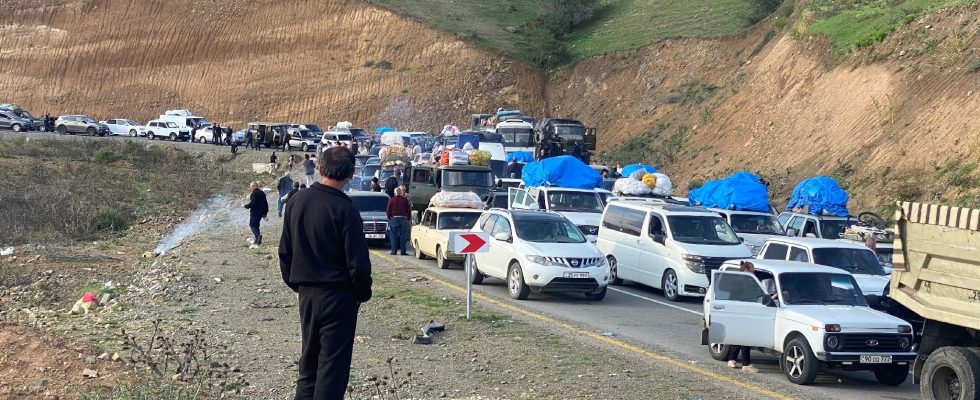“The first duty of the Armenian government is to welcome with the greatest care our brothers and sisters forcibly displaced from Nagorno-Karabakh, and to respond to their immediate needs,” said Prime Minister Nikol Pashinian, Thursday September 28. Since the beginning of the week, for hundreds of kilometers, lines of cars of residents of Nagorno-Karabakh have stretched along the winding Lachin road to first reach the Armenian towns of Goris or Kornidzor. This exodus began following the ceasefire concluded between the authorities of the enclave and Azerbaijan, for fear of ethnic cleansing.
Already nearly 80,000 refugees of Nagorno-Karabakh have registered in Armenia, a figure which is enough to make the Armenian government dizzy: the Prime Minister indeed indicated very recently that the State was only able to accommodate around 40,000 people.
Considering the huge traffic jams on the Armenian border, the number of refugees is expected to increase massively. Davit Babyan, former official of the Karabakh Republic, assured to Reuters that “99.9%” of the population will leave, knowing that 120,000 Armenians still populated Nagorno-Karabakh at the start of the month. This population no longer has any guarantee of security in the face of the “total integration” of the enclave into Azerbaijan, signed by the former president of the self-proclaimed republic on September 28. The separatist entity will officially cease to exist from January 1, 2024.
A disoriented population
Deprived of supplies for almost 10 months due to the blockade of the Lachin corridor by the Azerbaijanis, the Armenians of Nagorno-Karabakh are returning bloodless from their homeland. “They are traumatized, exhausted and hungry, and need psychosocial support and emergency assistance, including warm clothing and medicine,” explains the UNHCR (High Commission for Refugees).
“Many of them are disoriented, and have lost sight of their loved ones during the journeys to Armenia,” testifies the spokesperson for the ICRC (International Committee of the Red Cross), the only humanitarian organization on site to provide assistance. the first aid and care for refugees. During Azerbaijan’s offensive on September 19, thousands of Armenians had already had to escape inside the enclave. As they took to the road several days later to escape, hundreds were injured or died in mine explosions that littered parts of the route.
Housing and jobs crisis
The reception capacity of Armenia, a small mountainous republic of less than three million inhabitants, will be put to the test. “This will represent a significant shock for the country, which had certainly experienced the reception of thousands of Armenians from Karabakh in 2020, but not an exodus of such magnitude,” explains journalist Knar Khudoyan, based in Yerevan.
Everyone will first head to the capital, where 40% of Armenia’s population lives. The city has been gripped by an unprecedented housing crisis since last year, partly due to the arrival of tens of thousands of Russians who fled the partial mobilization decreed in Russia. “Apart from Yerevan, the rest of the country is not very developed. The best hospitals, schools and universities are in the capital, which will quickly be overwhelmed,” explains Benyamin Poghosyan, Armenian political scientist.
The Armenian government ensures this Friday having provided accommodation to 23% of the refugees already arrived, or around 17,000 people, a large part of whom in the regions. This government assistance concerns those who do not have family in Armenia. They are then temporarily installed in hotels, social centers and schools, specifies the UNHCR. But without international aid, the refugees cannot be taken care of with dignity, according to Benyamin Poghosyan, for whom help sent by the United States and the European Union of 25 million dollars is “insignificant” given the seriousness of the situation.
It’s a whole life that will have to be rebuilt, because everyone knows it: they will not return to Artsakh, the Armenian name for Nagorno-Karabakh. Without resources or employment in Armenia, these displaced people will have to integrate quickly, and not rely solely on the aid of 100,000 drams (around 240 euros) promised by the Prime Minister to each refugee. “It is not impossible that tensions will arise between the two populations: the Armenians of Armenia, and those recently arrived,” anticipates Knar Khudoyan, in a difficult economic context and a saturated job market.
For the moment, mutual aid seems to take priority: a large part of the national population is mobilizing to welcome the refugees from Karabakh. Facebook groups are being formed to distribute them to host families, while food and clothing collections are being organized on social networks to supply the displaced.
